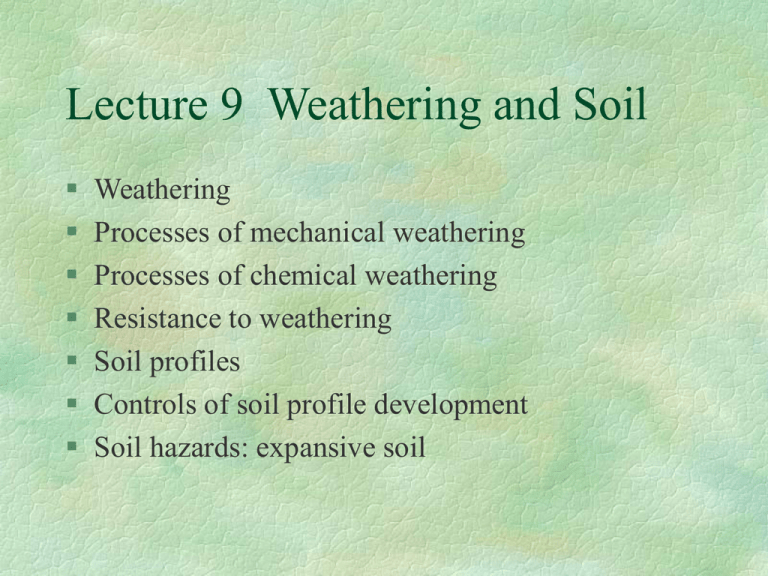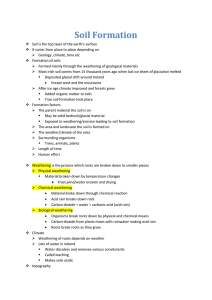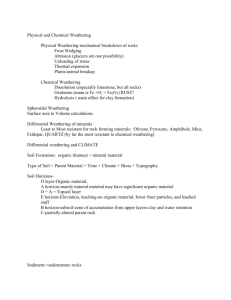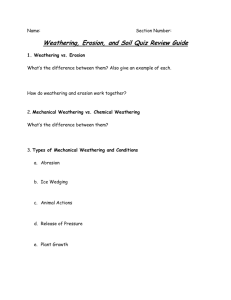Lecture 9 Weathering and Soil
advertisement

Lecture 9 Weathering and Soil Weathering Processes of mechanical weathering Processes of chemical weathering Resistance to weathering Soil profiles Controls of soil profile development Soil hazards: expansive soil What is weathering? Weathering is the physical breakdown (disintegration) and chemical alteration (decomposition) of rocks to form soil or loose particles at or near Earth's surface. Weathering causes deterioration of building materials. It also weakens rocks, a great concern when weathered rocks are used for foundation. Mechanical weathering is accomplished by physical forces that break rock into smaller and smaller pieces without changing the rock's mineral composition. Chemical weathering involves breaking down rock components and internal structure and forming new compounds. Whereas weathering breaks rocks apart, erosion removes rock debris by mobile agents such as water, wind, or ice. Photo by Stephen Marshak Contrasts between fresh and weathered granite. Stephen Marshak Mechanical weathering: unloading Upon removal of overburden (unloading), the elastic component of rock deformation is recovered and the rock expands, e.g. the overlying rocks are eroded or rocks are removed from a quarry. The expansion caused by unloading may be sufficient to fracture the rock. Such naturally formed cracks are called, joints. The unloading of large plutons may split into sheets that are parallel to the moutain face, a process called exfoliation. It is also known as sheeting if the expansion occurs in granite to form rock slabs. The exposure of once-deep rocks cause them to crack. Here, the pluton develops exfoliation and vertical joints, while the sedimentary rock layers developed mostly vertical joints. (W.W. Norton) Exfoliation joints in the Sierra Nevadas. (Martin Miller) Vertical joints in sedimentary rock (Brazil). (Stephen Marshak) Sheeting of in granite in Olmstead Point, Yosemite National Park, CA. Sheeting occurs as erosion removes the overlying rock cover and reduces the confining pressure. The bedrock expands, and large fractures develop parallel to the surface. Frost wedging may later enlarge the fractures. (Tarbuck and Lutgens) Mechanical weathering: Frost Wedging (Ice Wedging) Liquid water expand by 9% in volume when freezing. So one of the most effective mechanical weathering processes is the wedging action of repeated cycles of freezing and thawing of water in rock fractures. Conditions for frost wedging include moisture, rock fracture or weakness planes, and temperature fluctuation around the freezing point. A product of frost wedging is talus slope made of angular rock pieces piling up at the base of steep cliffs. An illustration of frost wedging. (Tarbuck and Lutgens). Talus slopes near Banff, Canada. (Hamblin and Christiasen). Salt Wedging: Growth of salt crystals shattered the wood fence posts near the shore of the Great Salt Lake, Utah. Saltwater seeps into the wood, and as it evaporates, salt crystals grow, expand, and break apart the wood fibers. (Hamblin and Christiansen). Mechanical weathering: thermal expansion and contraction As temperature changes, not all parts of a rock or all its minerals expand or contract by the same amount. So when rocks are heated or cooled, the mineral grains are subjected to differential stresses. These stones were once rounded stream gravels; however, long exposure in a hot desert climate disintegrated them. (C.B. Hunt, USGS). Processes of chemical weathering When rock comes in contact with components of the surface and atmosphere (water, oxygen, carbon dioxide), chemical reactions occur that alter and destroy minerals of the rock. Water is the most important agent of chemical weathering. surface area effects Chemical weathering occurs at the surfaces of rocks, thus, the greater the surface area, the more intense the weathering. Thus the breaking of rock into smaller pieces by mechanical weathering greatly accelerates chemical weathering. Chemical weathering: dissolution Water is an excellent solvent, capable of dissolving many chemical compounds. This is the result of polar nature of water molecules: the oxygen end has a small negative charge, the hydrogen end has a small positive charge.. In addition, CO2 in the atmosphere and soils reacts with water to produce carbonic acid. H2O + CO2 -> H2CO3. The carbonic acid readily reacts with calcite (e.g. in limestone and marble): CaCO3 + H2CO3 -> Ca2+ + CO2 + H2O. Dissolution Illustration of halite dissolving in water. A) Sodium and chloride ions are attached by the polar water molecules. B) Once removed, these ions are surrounded and held by a number of water molecules. Dissolution enlarges joints of a limestone and dissolves away sharp edges (Irland). (W.W. Norton) Chemical Weathering: Hydrolysis Hydrolysis is the reaction of acidic solutions with silicates (the most common mineral group). For example, the weathering of K-feldspar of granite is as follows. 2KAlSi3O8+ 2(H+ + HCO3-) + H2O -> K-feldspar carbonic acid Al2Si2O5(OH)4 + 2K+ + 2HCO3- + 4SiO2 kaolinite in solution silica An product of the chemical breakdown of K-feldspar is clay mineral, kaolinite, which is very stable at the surface. Consequently, clay minerals make up high percentage of soils. Chemical weathering: oxidation Iron-rich minerals is subject to oxidation, which occurs when oxygen (dissolved in the water) combines with iron to form iron oxide. 4Fe + 3O2 -> 2Fe2O3 (hematite) The once shiny, metallic pyrite is now oxidized and dull from chemical weathering. Rounded blocks of granitic rocks near Prescott, Arizona. (Tarbuck and Lutgens) Weathering attacks more vigorously at edges and most vigorously at corners, resulting in a rounded block. Resistance to weathering Rock characteristics Some minerals are more susceptible to chemical weathering than others. For silicates, the order of weathering (Goldrich's mineral stability series) is the same as the order of crystallization (so called Bowen's reaction series). Climate Climate is perhaps the single most important factor influencing weathering. Temperature and moisture have strong influences on both mechanical weathering (e.g. frost wedging) and chemical weathering. Thus chemical weathering is ineffective in polar regions or arid regions because of the lack of free water. Some rocks are more susceptible to chemical weathering than others. The granite headstone (left) was erected in 1888, a few years after the marble headstone in 1885 (right). (Tarbuck and Lutgens). The weathering of common silicate minerals: The order of weathering (Right, Goldrich's mineral stability series) is the same as the order of crystallization (so called Bowen's reaction series, Left). Climate controls the type and extent of weathering because of the combined effects of precipitation, temperature, and vegetation. Weathering is most pronounced in the tropics, where these factors reach maximum; and weathering is minimum in deserts and polar region, where these factors are minimal. Soil profiles One consequence of weathering is the formation of the soil profile, a vertical cross section from surface down to the parent materials. A well-developed soil profile shows distinct horizons. The major horizons are A, B, and C horizons. The A horizon is the top soil. It is a zone where downward percolating water removes soluble soil components into deeper zones (called leaching). It is also commonly rich in decomposed organic mater (humus). The B horizon is the sub soil or the zone accumulation where the material removed from above accumulates. The accumulation of fine clay particles enhances water retention in the subsoil. Organic matter is less abundant in the B horizon. The C horizon marks the transition from the soil profile to the unweathered parent material below. A soil profile is a vertical cross-section from the surface down to the parent material. Well-developed soils show distinct layers (called horizons). (E.J. Tarbuck). Idealized soil profile from a humid climate at mid latitudes. The major horizons are A, B, and C. (Tarbuck and Lugens). Controls of Soil Types. The thickness of a soil at a given climate depends on (a) the subtrate, (b) the steepness of a slope, and (c) the duration of soil formation. W.W. Norton Soil formation: parent material The parent material of soils can be (1) the underlying bedrock -- in this case, the soils are termed residual soils; or (2) transported deposits -- in this case, the soils are termed transported soils. The natural of parent material affect soils in two way. (1) The type of parent materials affects the rate of weathering. (2) The chemical make up of the parent material affects the soil's fertility, which affects vegetation. The parent material for residual soils is the underlying bedrock, whereas transported soils form on unconsolidated deposits. Note as slopes become steeper, soil becomes thinner. Soil formation: climate Climate is perhaps the most important in soil profile development. (1) As we pointed out above, temperature and precipitation have great influence on weathering. (2) The amount of precipitation affects how much various materials are leached from the soil, thereby affecting soil fertility. (3) Climate affects the type of plant and animal life present. Climate controls on Soil types: The prevailing climate has controlling influences on soil types. The soil types in the U.S. can be roughly described as pedalfers in the eastern half of the U.S. and pedocals in the western half. Pedalfer = pedon(soil)+Al(aluminum)+Fe(iron) in Greek. Pedalfers are found in the eastern U.S. with high precipitation. In pedalfers the soluble carbonates are removed and Al-rich clays and Fe oxides are carried downward to the B horizon. Pedocal = pedon(soil)+CALcite. Pedalcals contain an accumulation of calcium carbonate in the B horizon. Pedalcals are found in the drier western U.S. with grassland and brush vegetation. Three types of soils. (a) Well-defined soil horizons of pedalfer soils formed in a temperate climate. (b) Pedocal soils formed in desert cliamtes. A horizon is thin and soluble minerals can accumulate in B-horizon. (c) Laterite soils formed in tropical climates. An abundance of percolating water leaches just about all minerals, leaving only a dark-red mass of insoluble iron or aluminum oxide. (W.W. Norton) Soil formation: other factors Time In general, the longer a soil has been forming, the thicker it becomes and the less it resembles the parent material. Topography Steep slopes encourage runoff and erosion. Thus the soil profile thins near hilltops and thickens in the low lands. Vegetation Plants holds soil in place with their roots. Plants also provide organic matter to the soil, contributing to soil fertility or water retention. Soil hazards: expansive soil Soils containing swelling clays, primarily smectite, expand when absorbing water and shrink when losing it. Damage to structures caused by expansive soils is one of the most costly natural hazard in the U.S. (estimated 6 billion a year).







